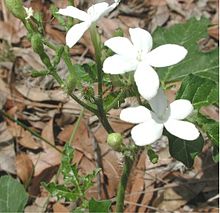- Spurge nettle
-
Spurge Nettle 
Scientific classification Kingdom: Plantae (unranked): Angiosperms (unranked): Eudicots (unranked): Rosids Order: Malpighiales Family: Euphorbiaceae Subfamily: Crotonoideae Tribe: Manihoteae Genus: Cnidoscolus Species: C. stimulosus Binomial name Cnidoscolus stimulosus
(Michx.) Engelm. & GraySpurge nettle (Cnidoscolus stimulosus), also known as Tread-softly and Finger Rot, is a perennial herb covered with stinging hairs, native to southeastern North America. A member of the family Euphorbiaceae (spurge family), it is not a true nettle. It prefers sandy, well-drained soil and mostly exists in pine/blackjack oak forests on sandhills, rims of Carolina bays, dunes, dry pastures, fields and roadsides.
The green leaves of this plant are alternate, consisting of three to five untoothed lobes. The large, white flowers have five petals. Male and female flowers are on different plants. Flowers occur throughout the spring and summer. The fruit is a small capsule that produces three large, edible seeds. The seeds are very tasty when ripe and were much used by various Indian tribes. Though difficult to excavate except on side hills, the tap root can be used as an excellent potato substitute, tasting like pasta.[1][2]
As the common names imply, the urticating hairs on this plant contain a caustic irritant that inflicts a painful sting to those who contact it with bare skin. It can cause a painful, irritating rash and can cause more serious reactions with some people.
The species name stimulosus comes from the Latin stimul(us), meaning to "goad", "prod" or "urge". This plant is also known as Bullnettle and Mala mujer (Spanish for "bad woman"), though the latter name is applied to several other plants with similar properties.
External links
- Cnidolscolus stimulosus - a site with plant information and excellent photographs.
- Tread-Softly Nettle
References
Categories:
Wikimedia Foundation. 2010.
